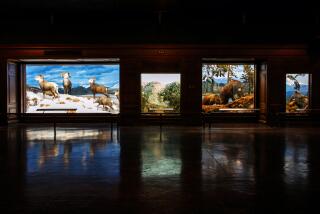O.C. ART REVIEW : Spector Exhibit at Newport Harbor Art Museum an Open Book
- Share via
NEWPORT BEACH — Using books as his principal material, Buzz Spector makes sculpture that is quiet, unassuming and ruminative in the extreme. The experience of looking at a small exhibition of his work at the Newport Harbor Art Museum through March 18 is akin to the half-searching, half-idle experience of rummaging through a neighborhood bookstore--but with a telling difference. Carved, torn, stacked, boxed, framed, painted over and, in a few cases, converted into pedestals, his books cannot be read.
The earliest work in the show, which was organized by associate curator Lucinda Barnes as part of the museum’s ongoing New California Artist series, establishes the parameters for the artist’s subsequent endeavors. “Evolution of a Life” (1981) is pointedly made from a used book of undetermined title, author and origin. Its first page has been torn out, close to the binding, and discarded; the second page has likewise been torn out, albeit slightly further from the binding. This procedure is repeated for each subsequent page, the sheets getting progressively larger as the book’s hidden narrative unfolds, until the very last page, which remains intact and whole.
The typically linear sequence of pages is deftly transformed into an evocation of a conscious life. Laying open in a display case, the book’s sequentially torn pages form a paper wedge whose white surface is peppered with an abstract scatter of typographic fragments of words and letters. In the “Evolution of a Life,” the beginning has vanished and cannot be recalled. The end, however, is whole, its text presumably full; yet, the denouement remains impossibly obscured behind the pileup of intervening leaves.
Ironically, you “read” this book by not being able to read it at all. This particular life may be an open book, but it’s no less mysterious for it.
Despite the material he employs, it would be a mistake to regard Spector’s work within the genre called artists’ books. Instead, he converts books into sculptural objects, or else he incorporates them into larger sculptural ensembles. The distinction, which claims the poetic work of the late Belgian conceptual artist Marcel Broodthaers as one obvious precedent and the slightly altered objects of Marcel Duchamp as another, is important. In Spector’s sculptures, the common relationship between a reader and a book gets upended.
A book is an intimate thing, meant to be held, even cradled while its meanings are revealed. A sculpture, by contrast, is typically untouchable, or distanced by its display inside a protective case or on a pedestal. By making books into sculptures, and in a few cases into pedestals on which other objects sit, Spector opens up a surprisingly wide range of conflicting responses: A spectrum from desire to frustration frames the experience of his work.
The exhibition includes 16 altered books and three mixed-media sculptures. In choosing his particular material, Spector has provocatively framed books as the principal intersection attempt to discover a rhyme or reason to the order of the stacked books--some secretly manufactured, faux Dewey-decimal system of subject, author, genre, date or even the color of the covers--seems doomed to failure. The only apparent quality all these books share is that the artist chose them, while their individual placement in the whole seems determined according to pragmatic fit. The sculpture, which is dated 1984-90, always remains the same, even though it changes utterly every time it is installed.
For reasons of sheer visibility, however, books on the top layer gain a certain stature over those hidden within the stacks (Philip Roth’s “Goodbye Columbus” assumes an added prominence, simply because it turns up twice). Meanwhile, those whose spines are visible on the face of each “step” form a kind of middle class of volumes. Despite the random order, the urge to find--to impose--some hierarchy or system of value remains strong.
If Spector’s art is typically unassuming, and if it sometimes teeters on the brink of collapsing into a solipsistic game, it nonetheless finds a certain solace in the gentle pleasure of its artistic endeavor. As your mind busies itself establishing an ever-more elaborate network of relationships, effortlessly careening “Toward a Theory of Universal Causality,” the sheer arbitrariness of the enterprise looms as its most surprisingly luxurious--and liberating--attribute.
Constructions by Buzz Spector are on view through March 18 at the Newport Harbor Art Museum, 850 San Clemente Drive, Newport Beach. Hours: 10 a.m. to 5 p.m. Tuesdays through Sundays. Admission: $1 to $3. Information: (714) 759-1122.
More to Read
The biggest entertainment stories
Get our big stories about Hollywood, film, television, music, arts, culture and more right in your inbox as soon as they publish.
You may occasionally receive promotional content from the Los Angeles Times.











